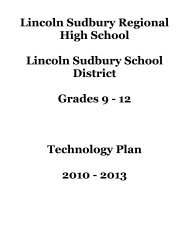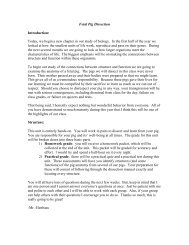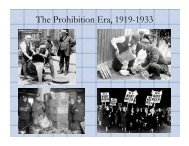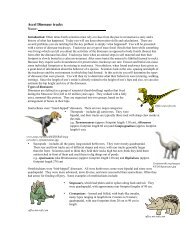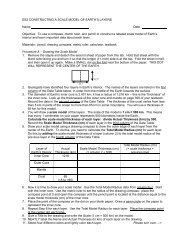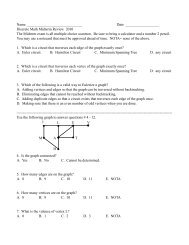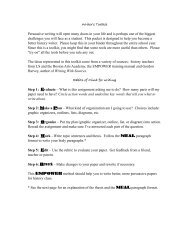Nifty Fifties Essay - Lincoln-Sudbury Regional High School
Nifty Fifties Essay - Lincoln-Sudbury Regional High School
Nifty Fifties Essay - Lincoln-Sudbury Regional High School
You also want an ePaper? Increase the reach of your titles
YUMPU automatically turns print PDFs into web optimized ePapers that Google loves.
20 th Century Name: _______________________________Ms. Shen<strong>Essay</strong> Assignment: The <strong>Nifty</strong> <strong>Fifties</strong>?Please take a position on the following statement and support your response with evidence from the unit and the attached primarydocuments:The media generally portrays the 1950s as a time of peaceful prosperity andunprecedented wealth – a time when all Americans, weary from years of warand economic hardship, were able to enjoy life. The 1950s, however, do notdeserve its reputation as one of peaceful consensus and conformity. Thisharmonic image was an overgeneralization that ignores the realities of what wasgoing on in this country.Paper Requirements: The paper should be 3-5 pages in length (no more!) A few formatting reminders:o Typed, double-spaced, Times New Roman (or comparable), size 12o Margins 1” all aroundo Name, class, and date should be single-spaced in the top left-hand cornero Header should be centered and also size 12 fonto Make sure pages are numbered (electronically) You must use footnotes or endnotes. Your citations, at least one per paragraph, should be drawn from the following: class notes, textbook, andthe documents provided to you in class. NO INTERNET WHATSOEVER. Remember to support yourargument with a blend of quotation analysis and specific historical examples. Consult your past written work, your research paper in particular, to see what you still need to work on,and set a writing goal for yourself. Don’t forget to proofread and spell check. You must use AT LEAST ONE quotation in each paragraph. All told, you should make use of AT LEASTFIVE separate primary documents (at least 3 direct quotes and at least 2 specific references). These primarysources should include the attached documents but may also include primary documents examined in class aswell.Due Dates / Time Table:Thursday, March 14 th : Thesis due; in-class work on the essay (along with test review)Monday, March 18 th & Thursday, March 21 st (Block 6) OR Tuesday, March 19 th & Thursday, March21 st (Block 5): Meet in the Humanities Lab to work on papersFriday, March 22 nd : <strong>Essay</strong>s are due!1
MORE INFORMATION ON WRITING A DBQThe essay question you have been given is a document-based question. This means that you will read and analyzea series of documents, and use these documents to answer the essay question. This section of the essay handout ismeant to help you learn how to approach and use the documents effectively.We will have time in class to review the documents and do brainstorming work that will help you answer thequestion.Step 1: Reading and Analyzing the Documents• Carefully read the question and think about what you already know about this topic. Write down any notes orideas that will be useful in your essay.• Examine each document and underline key phrases or quotes that you will later use as evidence in your essay.Basically you want to find quotes that will support the argument you are making. Be prepared to explain whatthe significance of your underlined passages is.• Prepare a detailed outline for your essay. (optional)Step 2: Writing the <strong>Essay</strong>1. Introduction: Give some background information about your topic (set the historical stage). Make sure yougive your reader enough information so that he or she knows what you are talking about. End your introductionwith your thesis statement. I repeat: The last sentence in your introduction should be your thesis. Make sure your thesisaddresses the fundamental question of the essay (see page 1); if you choose, you can elaborate and/or put it inyour own words, but your thesis should definitely address the question.2. Body Paragraphs: Each body paragraph (AT LEAST THREE) needs to start with an analytical topic sentence.Your topic sentence needs to make an argument that supports your thesis. Use quotations and references tosupport the argument. ALWAYS remember to analyze, or explain, how the quotations and evidence you usesupport your thesis. At the end of each paragraph, you should explain how the evidence you presented in thatparagraph AS A WHOLE connects back to your argument.NOTE: When using evidence from the documents, do not refer to them as “documents.” Rather, refer to themby their title (if available) or the author.Always make sure to properly “introduce” the document before you quote from it. For example:• Hugh Hefner argued that “Blah blah blah.”• Despite evidence to the contrary, Betty Freidan maintained her argument that “blah blah blah.”• According to Beat writer Alan Ginsberg, “Blah blah blah.”Remember to use AT LEAST ONE quotation in each paragraph. All told, you should make use of AT LEASTFIVE separate documents (at least 3 direct quotes and at least 2 specific references).3. Conclusion: Here is where you spend one paragraph summarizing your findings without being blatantlyrepetitive. You will need to re-emphasize your thesis as well as your main pieces of evidence without writing themexactly the same way over again. After you do this, you need to give your reader some additional insight into thetopic. For example, explain why these issues are important in the long run, or elaborate on the historicalsignificance of these particular issues.2
Pre-WritingDirections: To get you started on your essay, please begin brainstorming below. Be sure to include more than thegeneral points for either side. Consider the various documents we’ve studied in class thusfar and begin consideringwhich of these documents you could use to support your case on either side.1950s as a time of peace1950s as a decade of turmoilSample Intro Paragraph:The Truth Behind the <strong>Nifty</strong> <strong>Fifties</strong>The 1950s are generally remembered as a time of economic prosperity, social progression, and political stability. Theimage of the 1950s is revealed through television shows like “Leave it to Beaver,” in which a picture-perfect family led by anangelically beautiful mother and a friendly but manly father works out its problems and everyone is happy in the end. However,this image masks a reality of the 1950s that is, in reality, much more sinister. What one does not see in “Leave it to Beaver” is thatthe cookie-cutter culture of the 1950s obscured political hysteria, pervasive racial discrimination, and restrictive gender roles thatultimately limited the potential of women. As such, the image of the 1950s as a decade of peaceful consensus and conformity isinaccurate, and indeed, only cloaks the harsh reality of the 1950s.The fact that the Cold War raged throughout the 1950s left an indelible mark on the political reality of the era, leading toan intensively repressive political atmosphere.3
DOCUMENT ONE: Truman’s Loyalty ProgramThe DocumentsPRESCRIBING PROCEDURES FOR THE ADMINISTRATION OF AN EMPLOYEES LOYALTY PROGRAMIN THE EXECUTIVE BRANCH OF THE GOVERNMENTWhereas each employee of the Government of the United States is endowed with a measure of trusteeship over thedemocratic processes which are the heart and sinew of the United States; andWhereas it is of vital importance that persons employed in the Federal service be of complete and unswerving loyalty tothe United States; andWhereas, although the loyalty of by far the overwhelming majority of all Government employees is beyond question,the presence within the Government service of any disloyal or subversive person constitutes a threat to our democraticprocesses; andWhereas maximum protection must be afforded the United States against infiltration of disloyal persons into the ranksof its employees, and equal protection from unfounded accusations of disloyalty must be afforded the loyal employeesof the Government…PART I, -- INVESTIGATION OF APPLICANTSThere shall be a loyalty investigation of every person entering the civilian employment of any department or agency ofthe executive branch of the Federal Government…An investigation shall be made of all applicants at all available pertinent sources of information and shall includereference to:Federal Bureau of Investigation files. Civil Service Commission files. Military and naval intelligence files.The files of any other appropriate government investigative or intelligence agency. House Committee on un-AmericanActivities files. Local law-enforcement files at the place of residence and employment of the applicant, includingmunicipal, county, and State law-enforcement files. <strong>School</strong>s and colleges attended by applicant. Former employers ofapplicant. References given by applicant. Any other appropriate source.Whenever derogatory information with respect to loyalty of an applicant is revealed a full investigation shall beconducted…Harry S. TrumanThe White House, March 21, 1947Citation: Harry S. Truman, Federal Employee Loyalty Program, 1947.DOCUMENT TWO: Dwight D. Eisenhower, "Address Before the General Assembly of the United Nations onPeaceful Uses of Atomic EnergyOn July 16, 1945, the United States set off the world's first atomic explosion. Since that date in 1945, the United Statesof America has conducted 42 test explosions. Atomic bombs today are more than 25 times as powerful as the weaponswith which the atomic age dawned, while hydrogen weapons are in the ranges of millions of tons of TNT equivalent.Today, the United States' stockpile of atomic weapons, which, of course, increases daily, exceeds by many times theexplosive equivalent of the total of all bombs and all shells that came from every plane and every gun in every theatre ofwar in all of the years of World War II….But the dread secret, and the fearful engines of atomic might, are not ours alone…. The secret is also known by theSoviet Union…If at one time the United States possessed what might have been called a monopoly of atomic power, that monopolyceased to exist several years ago. Therefore, although our earlier start has permitted us to accumulate what is today agreat quantitative advantage, the atomic realities of today comprehend two facts of even greater significance….4
But let no one think that the expenditure of vast sums for weapons and systems of defense can guarantee absolutesafety for the cities and citizens of any nation. The awful arithmetic of the atomic bomb does not permit of any sucheasy solution. Even against the most powerful defense, an aggressor in possession of the effective minimum number ofatomic bombs for a surprise attack could probably place a sufficient number of his bombs on the chosen targets tocause hideous damage.Should such an atomic attack be launched against the United States, our reactions would be swift and resolute. But forme to say that the defense capabilities of the United States are such that they could inflict terrible losses upon anaggressor--for me to say that the retaliation capabilities of the United States are so great that such an aggressor's landwould be laid waste--all this, while fact, is not the true expression of the purpose and the hope of the United States…My country wants to be constructive, not destructive. It wants agreements, not wars, among nations. It wants itself tolive in freedom, and in the confidence that the people of every other nation enjoy equally the right of choosing theirown way of life.So my country's purpose is to help us move out of the dark chamber of horrors into the light, to find a way by whichthe minds of men, the hopes of men, the souls of men everywhere, can move forward toward peace and happiness andwell being….The United States knows that if the fearful trend of atomic military buildup can be reversed, this greatest of destructiveforces can be developed into a great boon, for the benefit of all mankind.The United States knows that peaceful power from atomic energy is no dream of the future. That capability, alreadyproved, is here--now--today. Who can doubt, if the entire body of the world's scientists and engineers had adequateamounts of fissionable material with which to test and develop their ideas, that this capability would rapidly betransformed into universal, efficient, and economic usage.Citation: Dwight D. Eisenhower, "Address Before the General Assembly of the United Nations on Peaceful Uses of Atomic Energy, New YorkCity," December 8, 1953. Online by Gerhard Peters and John T. Woolley, The American Presidency Project.http://www.presidency.ucsb.edu/ws/?pid=9774.DOCUMENT THREE: Montgomery, Alabama, Code on SegregationSec. 10. Separation of races—Required.Every person operating a bus line the in the city shall provide equal but separate accommodations for white people andNegroes on his buses, by requiring the employees in charge thereof to assign passengers seats on the vehicles undertheir charge in such manner as to separate the white from the Negroes, where there are both white and Negroes on thesame car. . . .Citation: Code of the City of Montgomery, Alabama, (Charlottesville: Michie City Publishing, 1952).DOCUMENT FOUR: Integration of Central <strong>High</strong> <strong>School</strong>, Little Rock, ARWhen the nine of us got together to compare notes, we discovered we were all facing an increasing barrage of injuriousactivities. What was noticeably different was the frequency and the organized pattern of harassment. Teams of studentsappeared to be assigned specific kinds of torture. One team concentrated on slamming us into lockers, while anotherfocused on tripping us up or shoving us down staircases; still another concentrated on attacks with weapons. Anothergroup must have been told to practice insidious harassment inside the classrooms. Still others worked at entrapment,luring the boys into dark corners or the girls into tight spots in isolated passageways.Citation: Melba Pattillo Beals, Warriors Don’t Cry (New York: Simon Pulse, 1995), 213.5
DOCUMENT FIVE: Brown v. Board of Education DecisionSegregation of white and colored children in public schools has a detrimental effect upon the colored children. Theimpact is greater when it has the sanction of the law; for the policy of separating the races is usually interpreted asdenoting the inferiority of the Negro group. A sense of inferiority affects the motivation of a child to learn. Segregationwith the sanction of law, therefore, has a tendency to retard the educational and mental development of Negro childrenand to deprive them of some of the benefits they would receive in a racially integrated school system. Whatever mayhave been the extent of psychological knowledge at the time of Plessy v. Ferguson, this finding is amply supported bymodern authority. Any language in Plessy v. Ferguson contrary to this finding is rejected.Citation: Brown v. Board of Education, 347 U.S. 483 (1954).DOCUMENT SIX: Folk Song: Little Boxes by Malvina ReynoldsLittle Boxes on the hillside, little boxes made of ticky tacky,Little Boxes on the hillside, little boxes all the same,There's a green one and a pink one, and a blue one and a yellow one,And they're all made out of ticky tacky and they all look just the same.And the people in the houses all went to the university,Where they were put into boxes and they all came out the same,And there's doctors and lawyers, and business executives,And they're all made out of ticky tacky and they all look just the same.And they all play on the golf course and drink their martini dry,And they all have pretty children and the children go to schoolAnd the children go to summer camp and then to the university,Where they are all put in boxes and they all come out the same.Citation: "Little Boxes," folk song, 1962. Words and music by Malvina Reynolds, 1962. Schroder Music Co.DOCUMENT SEVEN: Quotation from a Suburban Housewife"We were all in the same boat . . . We shared everything; we shared tools and cars, minded each other's kids, passedplay-pens and high-chairs from house to house—everything. It was—at least to us—a Paradise."Citation: Mrs. Klerk, quoted in Barbara M. Kelly, Expanding the American Dream: Building and Rebuilding Levittown, (Albany: StateUniversity of New York, 1993).DOCUMENT EIGHT:Excerpt from The Affluent Society, by John Kenneth GalbraithPoverty—grim, degrading, and ineluctable—is not remarkable in India. For few, the fate is otherwise. But in the UnitedStates, the survival of poverty is remarkable. We ignore it because we share with all societies at all times the capacity fornot seeing what we do not wish to see. Anciently this has enabled the nobleman to enjoy his dinner while remainingoblivious to the beggars around his door. In our own day, it enables us to travel in comfort by Harlem and into the lushprecincts of midtown Manhattan. But while our failure to notice can be explained, it cannot be excused. "Poverty," Pittexclaimed, "is no disgrace but it is damned annoying." In the contemporary United States, it is not annoying but it is adisgrace.Citation: John Kenneth Galbraith, The Affluent Society, 4th ed. (Boston: Houghton Mifflin, 1984), 254.6
DOCUMENT NINE: Excerpt from The Other America, by Michael HarringtonThere is a familiar America. It is celebrated in speeches and advertised on television and in the magazines. Ithas the highest mass standard of living the world has ever known.In the 1950s this America worried about itself, yet even its anxieties were products of abundance. The title of abrilliant book was widely misinterpreted, and the familiar America began to call itself “the affluent society.” […] In allthis, there was an implicit assumption that the basic grinding economic problems had been solved in the United States.In this theory the nation’s problems were no longer a matter of basic human needs, of food, shelter, and clothing. Nowthey were seen as qualitative, a question of learning to live decently amid luxury.While this discussion carried on, there existed another America. In it dwelt somewhere between 40,000,000and 50,000,000 citizens of this land. They were poor. They still are.To be sure, the other America is not impoverished in the same sense as those poor nations where millions clingto hunger as a defense against starvation. This country has escaped such extremes. That does not change the fact thattens of millions of Americans are, at this very moment, maimed in body and spirit, existing at levels beneath thosenecessary for human decency. If these people are not starving, they are hungry, and sometimes fat with hunger, for thatis what cheap foods do. They are without adequate housing and education and medical care.The Government has documented what this means to the bodies of the poor…But even more basic, thispoverty twists and deforms the spirit. The American poor are pessimistic and defeated, and they are victimized bymental suffering to a degree unknown in Suburbia…The millions who are poor in the United States tend to become increasingly invisible. Here is a great mass ofpeople, yet it takes an effort of the intellect and will even to see them.Citation: Michael Harrington, The Other America, (New York: Scribner, 1962), 1-2.DOCUMENT TEN: A Neighborhood VoteResidents of the Southwood District of South San Fransisco were triumphant yesterday in their efforts to keep theirneighborhood 100% Caucasian. They achieved this object by the use of one of democracy’s most fundamental instruments –the secret ballot. By a vote of 174 to 26 they told Sing Sheng, a former Chinese Nationalist intelligence officer, that they did notwant him, his pretty wife and his small son as neighbors. They did not want the Shengs as neighbors for a lot of reasons whichadded up to one big reason: the Shengs are Chinese….The suggestion of putting the matter to a ballot came from Sheng himself after he receieved numerous objections to hispurchase of a house on West Orange Avenue last week. Most of the objections asserted that his presence would depressproperty values. “I didn’t know about any racial prejudice at all until I came to Southwood. I was sure everybody really believedin democracy, so I thought up this vote as a test,” he said at that time…Each ballot was tallied aloud, read by South San Franscisco City Manager Emmons McClung. The ballots were phrased so thatthe homeowners were asked whether they objected to the purchase of a home in the neighborhood by this Chinese family…TheShengs heard McClung read the phrase, “I object,” 174 times as he tallied the ballots. By the end of the balloting they lookedcrushed…The homeowners exchanged jubilant remarks as they drifted out of the hall.Citation: David Colbert, Ed., Eyewitness to America, New York: Pantheon Books, 1997.7
DOCUMENT ELEVEN: The Suburban CommunityBroad Classes of Reasons Given for Moving to the Suburbs, and Percentage of Respondents Mentioning Each Type(*Since many respondents gave more than one reason, the sum of the percentages does not equal 100.)Type of ReasonPer Cent*Better for children 81Enjoy life more 77Husband's job 21Near relatives 14Other 3Percentage Distribution of Specific Reasons in the "Better for Children" Category:Specific Reasons for Moving to the SuburbsPer CentPhysical reasons (N=172): 72.3More space outside house 19.7More space inside house 14.3"The outdoors" (fresh air, sunshine, etc.) 12.6Less traffic 11.8Cleaner 6.3No neighbors in same building 3.8Quiet 2.1No stairs 1.7Social reasons (N=66): 27.7Better schools 10.2"Nice" children to play with 9.2Other children to play with 2.5More organized activities 2.5Home of own (security) 1.7Adults "nice" to children 0.8Better churches 0.8Total reasons in this category (N=238) 100.0Citation: Wendell Bell, "Social Choice, Life Styles, and Suburban Residence," in The Suburban Community, ed. William Dobriner (NewYork: Putnam, 1958), 234–35.8
DOCUMENT TWELVE: Memoir about cruisin’ and draggingBackground information: This memoir describes a teenager's love affair with cars during the 1950s. The car became avehicle of freedom and expression during this decade. Problematically, many of these freedoms were in direct contrastto the "perfect" family image, such as the dangers of drag racing and the flirtatious rituals of cruising.Between 1957 and 1959, my friends and I learned all the rituals that young boys needed to know concerning driving.We learned how important it was to be noticed behind the wheel of a fast car or with someone who had one. It was atime in our lives that we had looked forward to having seen those slightly older than us doing the same things.I was lucky in having a friend like Bobby Patton who seemed to have unlimited use of a Plymouth Fury owned by hisfamily. He had been a friend throughout high school and now it became important to maintain that status at any cost.He knew the cruising rules better than I having had an older sister to observe as she went through this time a couple ofyears ahead of us.The cruising part required that one first drive up and down Main Street as soon as the school day was completedmaking sure that you were seen by all. It might even involve stopping at Mabry’s or Birmingham’s drug stores for aquick vanilla coke and a look at the girls who happened to be there. Then up and down any of the streets leading fromHamlet <strong>High</strong> toward any of the girls’ homes we thought worthy of our attention. This was a chance to "give them a ridehome" (our excuse) and yet be seen by someone else with them in the car (our intent).After dropping the unsuspecting (we thought) girls off at home, the cruising began in earnest. Up and down Main Streetagain, then through the neighborhoods where our favorite girls lived. Passing one of their houses always required a tooton the horn to let them know we were around. Nothing was ever said of this ritual, during, before or after the fact.They understood we were required to do it and so did we. Nothing need be said.After going home to supper and supposedly doing our homework, the real cruising would begin. A typical school nightwould find us out in that grand old Plymouth Fury V-8 with slightly loud, glass packed mufflers driving around the cityof Hamlet. It was extremely important to "drag" the Hub before, during and after cruising around town. The Hub ritualis described on another of our stories on this site.If we were lucky, we would find ourselves at a stoplight or corner with someone else in just as powerful a car. It couldbe a customized hot rod, a ’57 Chevy, even a Willis or Oldsmobile 88 or 98. Then it was off to the races, squealing tires,burning rubber for a block or two. We just had to see who had the fastest car. It was totally for bragging purposes evenif only for a day. I’m glad our parents didn’t know how rough we were on the family cars, or if they did, I’m glad theydidn’t say too much about it.Weekends were a totally different style. Those were the nights you weren’t expected home by 10:00 p.m. Those werethe nights when you made sure you had your best girl with you… the nights you lived for.Double dating was always best. That way you had plenty of help if you found yourself lacking conversational skills. Youhad eye witnesses that you had been close to your date, that you had sneaked your fair amount of kisses. You had proofthat your girl really loved you and that her parents trusted you enough to let her go with you in a car. Oh, what afeeling. Those nights were nights to remember… to talk about the next day with your best friend.. to hold onto forever.We were transformed from boys to men!Citation: Russ Lancaster, http://www.irememberhamlet.com/cruisingdragging.html, 1957.9
How to Use Endnotes/Footnotes1. Foot/endnotes should be written in the form of traditional number symbols (1, 2, 3, 4).2. Each citation should have a different number, regardless of whether you are using the same sourcemultiple times.3. Foot/endnotes should NOT be written in by hand – they should be integrated and typed into the textusing the instructions provided below.4. Foot/endnotes should be incorporated in the paper after the following scenarios:a. After using a direct quote from a text, person, or other resource.b. After including important specific information, ideas, or arguments obtained from another resource ortext (i.e. statistics, factual information, author’s interpretation of an event, etc.)c. As a general rule, it is better to over-cite than to under-cite and risk plagiarizing.5. Format for endnotes and footnotes:a. For books, textbooks, other secondary sources:i. First and last name of author, Title of book, (city of publication, state: publisher, year), pagenumber where the information was found.b. For primary documents:i. (If possible) First and last name of author, Title of document, (year written), page number (ifpossible).c. For handouts used in class:i. 20 th Century, “Name of handout”, (date of class if known).d. For notes taken in class:i. 20 th Century, “Lecture notes from (insert date here)”, Ms. Shen, <strong>Lincoln</strong>-<strong>Sudbury</strong> <strong>Regional</strong> <strong>High</strong><strong>School</strong>.6. How do you insert a footnote or endnote into the text of your paper?a. Microsoft Word:i. Place the cursor at the end of the sentence (after the period) and go to “Insert” on the toolbar atthe top of the screen.ii. In the drop down menu, select either “reference” or “footnote” (depending on your version ofWord).iii. This will bring up a box - make sure “AutoNumber” is selected and that the numbers are in thetraditional number form (i.e. 1, 2, 3, etc.)iv. Hit “OK” and a number should be magically inserted into the text where the cursor was. Youwill now be dropped down to the bottom of the page (or the end of the paper if you are usingendnotes) where you will fill in the details for the source (author, etc.)b. Pages:i. Place the cursor at the end of the sentence (after the period) and go to “Format” on the toolbarat the top of the screen.ii. In the drop down menu, select “Insert Footnote”iii. This should magically insert a number in the text where the cursor was. You will now bedropped down to the bottom of the page (or the end of the paper if you are using endnotes)where you will fill in the details for the source (author, title, etc.)iv. The first tab (“Documents”) in the Inspector has an option for choosing between footnotes andendnotes (if you prefer one over the other.10


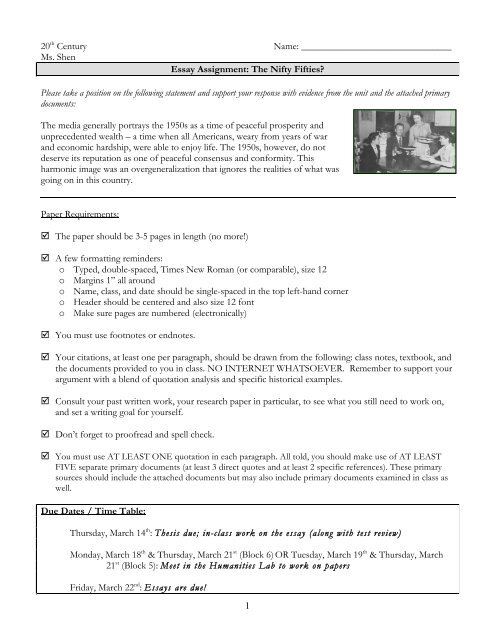
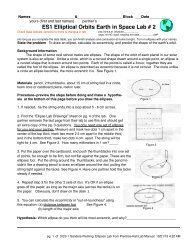

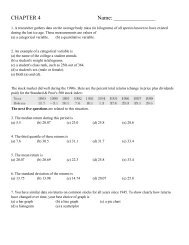
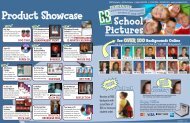
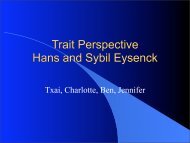
![';1asAu ro; las I sgeo8 leuo!]eslanuol aql utelqo o1 palenttouJ ue I ...](https://img.yumpu.com/49072782/1/190x221/1asau-ro-las-i-sgeo8-leuoeslanuol-aql-utelqo-o1-palenttouj-ue-i-.jpg?quality=85)
